The Intel SSD 600p (512GB) Review
by Billy Tallis on November 22, 2016 10:30 AM ESTRandom Read Performance
The random read test requests 4kB blocks and tests queue depths ranging from 1 to 32. The queue depth is doubled every three minutes, for a total test duration of 18 minutes. The test spans the entire drive, which is filled before the test starts. The primary score we report is an average of performances at queue depths 1, 2 and 4, as client usage typically consists mostly of low queue depth operations.
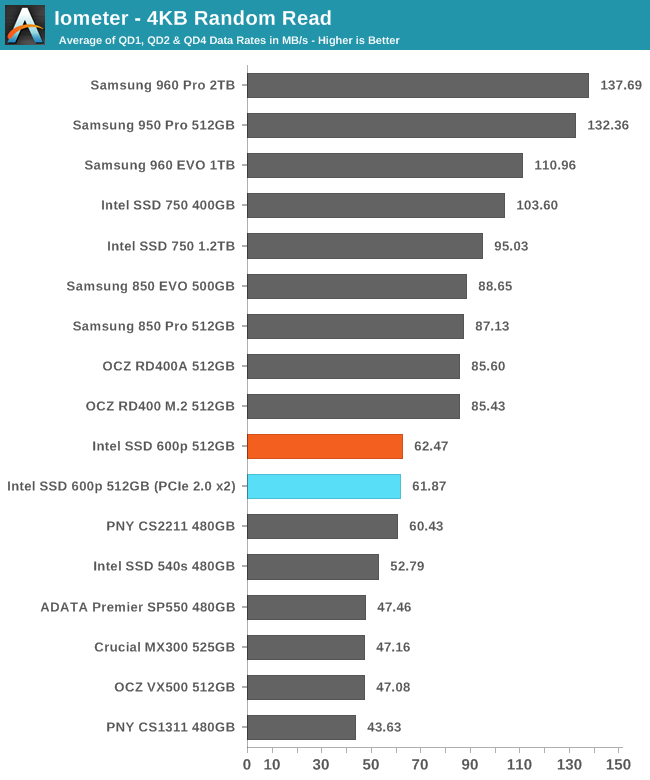
The Intel 600p has faster random reads than budget SATA SSDs, but it is significantly behind the Samsung 850 EVO.
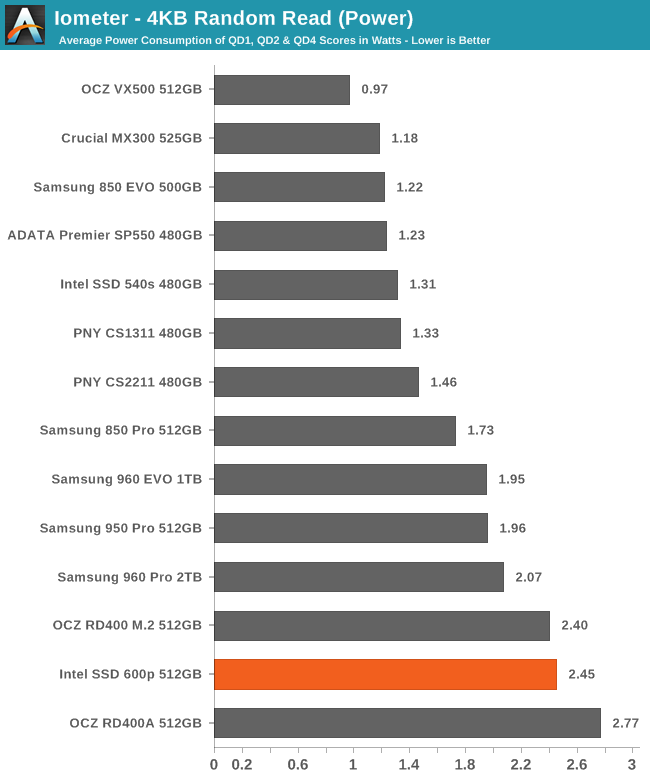
As usual, the 600p's power consumption is high, but not egregiously so: 2.45W is usually not high enough for thermal throttling to be a concern for M.2 SSDs.
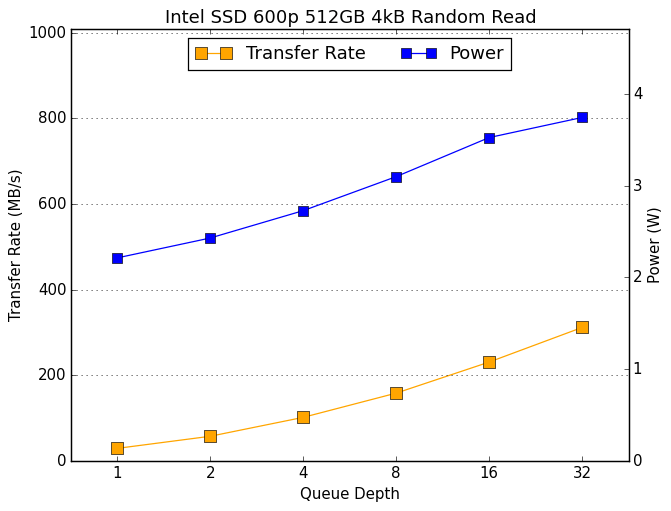 |
|||||||||
The 600p's performance grows slowly as queue depth increases, and even at QD32 it has not reached the SATA speed limit that Samsung's SATA drives hit at QD16.
Random Write Performance
The random write test writes 4kB blocks and tests queue depths ranging from 1 to 32. The queue depth is doubled every three minutes, for a total test duration of 18 minutes. The test is limited to a 16GB portion of the drive, and the drive is empty save for the 16GB test file. The primary score we report is an average of performances at queue depths 1, 2 and 4, as client usage typically consists mostly of low queue depth operations.
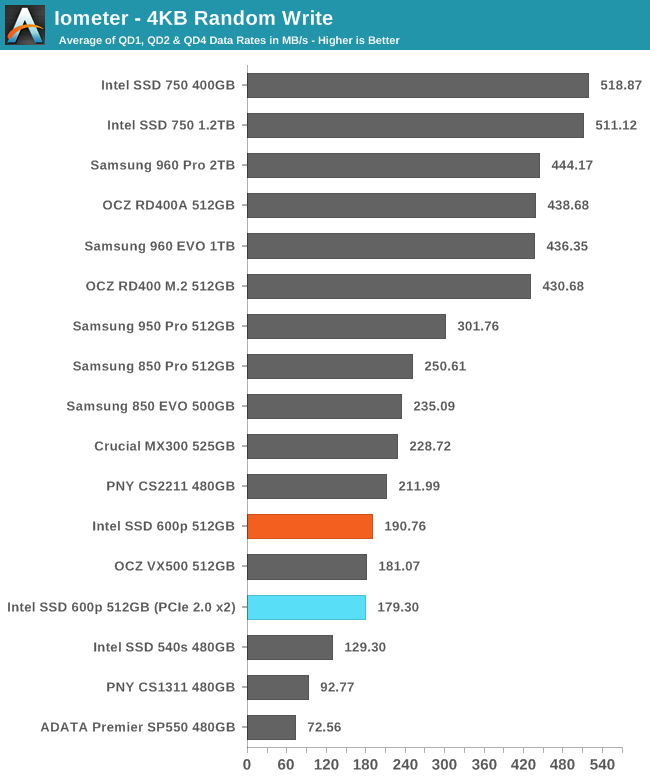
The 600p had above-average steady-state QD32 random write performance, but this shorter test of low queue depths puts the 600p only barely ahead of the slowest MLC SSD in this collection.
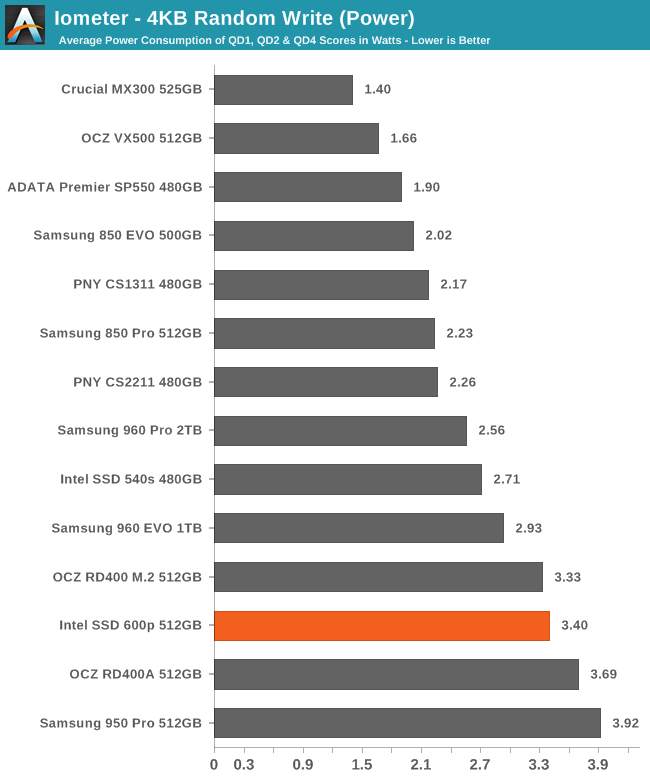
The 600p uses more power than most drives, but unlike the Samsung 950 Pro it isn't brushing up against the practical TDP limits of the M.2 form factor even at lowest queue depths.
 |
|||||||||
It is clear that the 600p's random write performance improves from QD1 to QD2, but after that all we're seeing in this graph is the same steady state variations we saw in the hour-long QD32 consistency test, potentially with some thermal throttling.










63 Comments
View All Comments
Billy Tallis - Thursday, November 24, 2016 - link
They're in Bench now.Flying Aardvark - Friday, November 25, 2016 - link
I have the 1TB 600P and love it. I bought it knowing full well it wasn't a benchmark king. Don't care, low QD performance has hardly improved for quite some time. But at the price, for a 5-year warranty with 0.3% failure rate per year was a no brainer over the 960 EVO for me.I can't get it to slow down or stutter in my case and if you can, you should probably step all the way up to the Intel 750, heatsink intact and all.
crazyowl - Sunday, November 27, 2016 - link
I'm not sure now to formulate this correctly so as not to hurt the reputation of the product, but there's been a report of a 600p burning a motherboard's traces when installed via a DeLonghi adapter card. Anandtech, what could you comment on that issue? Came across it in a review for the 600p at a respectable decent online shop.crazyowl - Sunday, November 27, 2016 - link
Sorry, it was DeLock, not DeLonghi. The latter seems to be a houseware brand.Billy Tallis - Sunday, November 27, 2016 - link
Our testing showed the 600p to be relatively power hungry by the standards of M.2 PCIe SSDs, but it most certainly wasn't drawing enough current to be a danger to any equipment that is capable of safely powering other M.2 PCIe SSDs. Whatever you read about was likely the result of either a manufacturing defect in the board that was supplying power to the M.2 drive, or the result of improper installation leading to a short circuit. I've killed a motherboard through the latter means, but it was only due to the modifications I've made to facilitate measuring PCIe card power consumption.Xajel - Monday, November 28, 2016 - link
I would love to have an NVMe SSD, sadly my system is old (ASUS P8Z77 ) so, it's not able to boot from NVMe.. although nothing is wrong with the chipset it can do it, but ASUS never released any BIOS update, there's some unofficial mod's which can enable this but there's no guarantee it will work or it will brick.el-loc0 - Monday, November 28, 2016 - link
@Anandtec: what equipment do you use to measure power consumption?Billy Tallis - Tuesday, November 29, 2016 - link
For PCIe SSDs, I use a riser card from Adex Electronics with current sense resistors on the 3.3V and 12V supply lines. For SATA SSDs, I use a multimeter spliced into the power cable to measure current directly.el-loc0 - Tuesday, November 29, 2016 - link
Thanks for quick reply, Billy. Do PCIe SSD Draw Power from both lines, 3.3 V and 12 V? Do you use a current clamp or how do you measure on the riser card? Which multimeter do you use?SanX - Thursday, December 1, 2016 - link
Did Intel pay for this BS review?